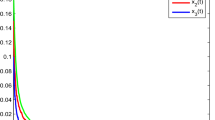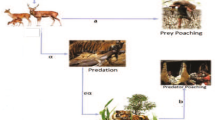Abstract
Models of single-species and predator-prey systems in a polluted closed environment are developed and partially analyzed. Three cases are considered: a single influx of toxicant, a constant influx of toxicant, and a periodic pollution of the environment. In the case of single-species growth we are able to determine some local and global dynamics. In the case of predator-prey systems, we investigate the existence of steady states for a small constant influx of toxicant.
On leave from Department of Mathematics, Indian Institute of Technology, Kanpur, India
Similar content being viewed by others
References
Butler, G. J., Freedman, H. I., Waltman, P.: Uniformly persistent systems, Proc. Am. Math. Soc. 96, 425–430 (1986)
Luna, de J. T., Hallam, T. G.: Effects of toxicants on populations: a qualitative approach IV. Resource-consumer-toxicant models. Ecolog. Model. 35, 249–273 (1987)
Freedman, H. I.: The implicit function theorem in the scalar case. Can. Math. Bull. 12, 721–732 (1969)
Freedman, H. I.: Deterministic mathematical models in population ecology. Edmonton: HIFR Consulting Ltd. 1987
Freedman, H. I., So, J. W.-H.: Global stability and persistence of simple food chains. Math. Biosci. 76, 69–86 (1985)
Haas, C. N.: Application of predator-prey models to disinfection. J. Water Pollut. Control. Fed. 53, 378–386 (1981)
Hallam, T. G., Clark, C. E.: Nonautonomous logistic equations as models of populations in a deteriorating environment. J. Theor. Biol. 93, 303–311 (1982)
Hallam, T. G., Clark, C. E., Jordan, G. S.: Effects of toxicants on populations: a qualitative approach II. First order kinetics. J. Math. Biol. 18, 25–37 (1983)
Hallam, T. G., Clark, C. E., Lassiter, R. R.: Effects of toxicants on populations: a qualitative approach I. Equilibrium environmental exposure. Ecolog. Model. 18, 291–304 (1983)
Hallam, T. G., de Luna, J. T.: Effects of toxicants on populations: a qualitative approach III. Environmental and food chain pathways. J. Theor. Biol. 109, 411–429 (1984)
Jensen, A. L., Marshall, J. S.: Application of a surplus production model to assess environmental impacts on exploited populations of Daphnia pluex in the laboratory. Environ. Pollut. (Ser. A) 28, 273–280 (1982)
Lancaster, P. L., Tismenetsky, M.: The Theory of Matrices, Second Edition. New York: Academic Press 1985
Nelson, S. A.: The problem of oil pollution of the sea. In: Advances in Marine Biology, pp. 215–306. London: Academic Press 1970
Shukla, J. B., Freedman, H. I., Pal, V. N., Misra, O. P., Agarwal, M., Shukla, A.: Degradation and subsequent regeneration of a forestry resource: a mathematical model. Ecolog. Model. 44, 219–229 (1989)
Woodman, J. N., Cowling, E. B.: Airborne chemicals and forest health. Environ. Sci. Technol. 21, 120–126 (1987)
Author information
Authors and Affiliations
Additional information
Research partially supported by the Natural Sciences and Engineering Research Council of Canada, Grant No. NSERC A4823
Rights and permissions
About this article
Cite this article
Freedman, H.I., Shukla, J.B. Models for the effect of toxicant in single-species and predator-prey systems. J. Math. Biol. 30, 15–30 (1991). https://doi.org/10.1007/BF00168004
Received:
Revised:
Issue Date:
DOI: https://doi.org/10.1007/BF00168004




